The Single-use Bioreactors Market is estimated to be valued at USD 6.0 billion in 2025 and is projected to reach USD 23.7 billion by 2035, registering a compound annual growth rate (CAGR) of 14.7% over the forecast period.
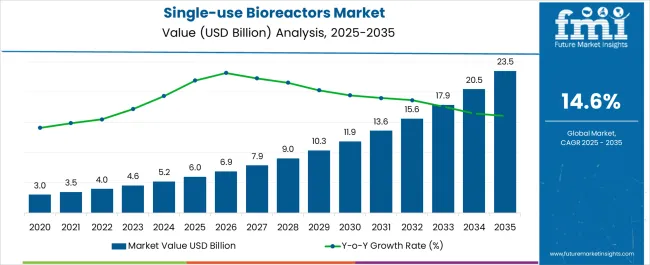
| Metric | Value |
|---|---|
| Single-use Bioreactors Market Estimated Value in (2025 E) | USD 6.0 billion |
| Single-use Bioreactors Market Forecast Value in (2035 F) | USD 23.7 billion |
| Forecast CAGR (2025 to 2035) | 14.7% |
The single-use bioreactors market is progressing at a rapid pace, driven by the increasing shift of the biopharmaceutical industry toward flexible, cost-effective, and scalable manufacturing solutions. Industry journals and corporate reports have emphasized that single-use technologies are addressing key challenges in biologics production by reducing contamination risks, lowering turnaround time, and minimizing cleaning and validation requirements.
The surge in demand for monoclonal antibodies, vaccines, and cell and gene therapies has further accelerated adoption, as companies prioritize agility in scaling clinical and commercial production. Investments in biomanufacturing facilities and technology partnerships between suppliers and pharmaceutical firms have expanded global capacity for single-use systems.
In addition, regulatory acceptance of single-use technologies and their role in enabling continuous processing have provided strong growth momentum. Looking forward, market expansion will be supported by the rising number of contract development and manufacturing organizations (CDMOs) adopting single-use platforms, alongside technological improvements that enhance mixing, oxygen transfer, and monitoring capabilities.
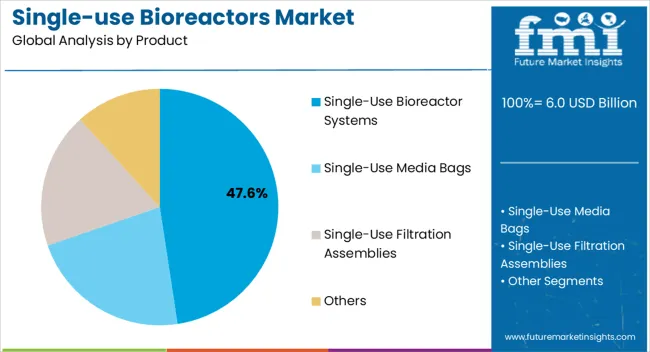
The Single-use Bioreactor Systems segment is projected to account for 47.6% of the single-use bioreactors market revenue in 2025, maintaining its leadership position. Growth in this segment has been supported by its ability to streamline biomanufacturing processes, offering reduced capital expenditure and operational flexibility compared to traditional stainless-steel systems.
Reports from bioprocessing companies have indicated that adoption has been accelerated by shorter development cycles and rapid scale-up requirements in biologics production. Furthermore, the elimination of cleaning-in-place and sterilization-in-place processes has lowered water and energy consumption, aligning with sustainability goals across the biopharma sector.
The broad applicability of single-use systems in upstream processes, coupled with improvements in bag integrity and sensor integration, has strengthened their adoption. As biopharmaceutical pipelines diversify with complex molecules, demand for these systems is expected to remain high, sustaining the segment’s market share.
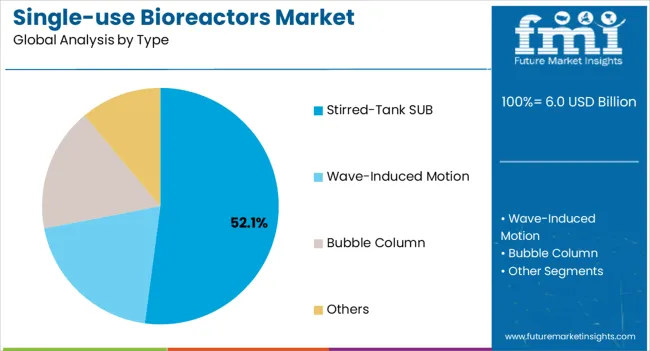
The Stirred-Tank SUB segment is projected to contribute 52.1% of the single-use bioreactors market revenue in 2025, establishing itself as the dominant type. This growth has been attributed to the versatility of stirred-tank designs, which closely replicate the performance of conventional stainless-steel reactors while offering the benefits of disposability.
Technical literature has highlighted that stirred-tank systems provide superior control of mixing, aeration, and scalability, making them the preferred choice for both clinical and commercial biomanufacturing. Biopharma companies have increasingly selected stirred-tank SUBs due to their compatibility with a wide range of cell lines and culture processes, including high-density perfusion applications.
Furthermore, suppliers have enhanced system robustness through innovations in impeller design and integrated process monitoring. The ability of stirred-tank SUBs to serve as a flexible platform across diverse therapeutic modalities has reinforced their leading role in the market.
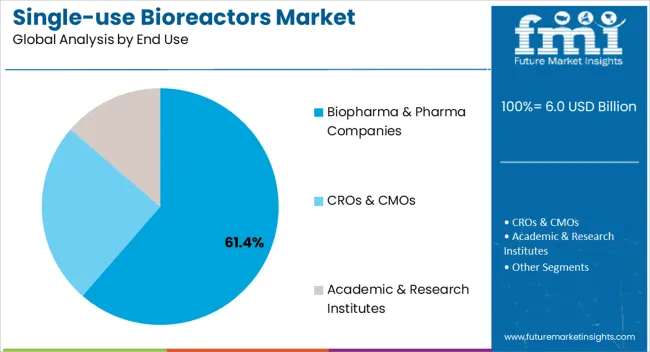
The Biopharma & Pharma Companies segment is projected to hold 61.4% of the single-use bioreactors market revenue in 2025, retaining its position as the primary end-user group. Growth in this segment has been driven by the need to accelerate development timelines and optimize production efficiency in biologics manufacturing.
Annual reports and press releases from leading pharmaceutical firms have emphasized strategic investments in single-use technologies to expand manufacturing agility and reduce infrastructure costs. The scalability of single-use bioreactors has enabled biopharma companies to move seamlessly from clinical trials to commercial production, which has become essential given the rising demand for biologics and biosimilars.
Additionally, single-use technologies have provided greater operational flexibility for multiproduct facilities, reducing downtime between production runs. With the continued expansion of biologics pipelines and global demand for vaccines and cell therapies, the Biopharma & Pharma Companies segment is expected to maintain its dominance, supported by large-scale adoption of single-use systems across manufacturing networks.
The global single-use bioreactors market is expected to witness a CAGR of 15.4% in the forecast period. It grew at a steady CAGR of 16.7% in the historical period between 2020 and 2025.
In recent years, pharmaceutical and biotechnology sectors have placed a growing emphasis on supply chain resilience. Manufacturing and delivery of vital medications & therapies can be severely hampered by problems with the supply chain.
Several issues could be observed during the epidemic, natural catastrophes, or geopolitical events. Single-use bioreactors have become an effective way to improve supply chain resilience in this situation for a number of reasons.
Traditional stainless-steel bioreactors require rigorous cleaning, sterilization, and validation procedures. But, single-use bioreactors are pre-sterilized, pre-assembled, and provide ready-to-use. This would shorten lead times and make inventory management simpler while streamlining the logistics of purchasing & deploying bioreactors.
Single-use bioreactors provide quick switchovers and rapid bioprocess start-ups as no cleaning and validation activities are needed in between batches. Due to their flexibility, biopharmaceutical companies might swiftly respond to changes in demand. They can further modify production schedules and deal with unforeseen supply chain difficulties.
There is also no chance of cross-contamination between different production runs or batches as single-use bioreactors are thrown away. For the safety and quality of delicate biopharmaceutical products, this is set to become very important.
Single-use bioreactors have the capacity to scale for different batch sizes, which might make it simpler to change production volumes in response to demands. Additionally, they make it easy to transfer technologies between several manufacturing facilities. They might hence allow businesses to expand their production capacities and reduce supply chain risks associated with a single location.
With third-party contract development and manufacturing organizations (CDMOs), single-use bioreactors make outsourcing & contract manufacturing arrangements easier. Due to their increased ability to use outside resources to supplement their internal skills, businesses are less dependent on a single site or provider. Owing to the aforementioned factors, single-use bioreactor demand might expand.
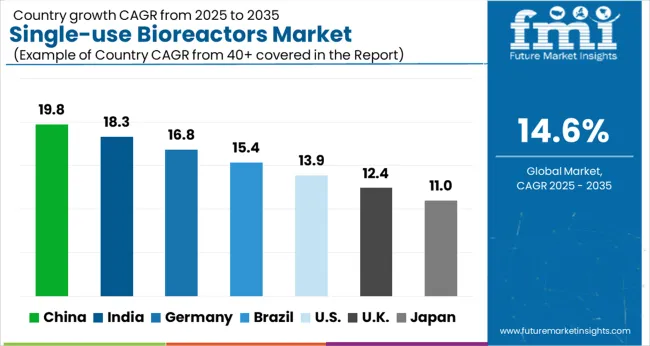
The United Kingdom single-use bioreactors market is projected to record a CAGR of 15.1% in the assessment period. It is anticipated to top a valuation of USD 23.7 million by 2035.
The United Kingdom government has provided incentives and financing for life sciences research & development to help the biopharmaceutical sector. Such regulations might incentivize biopharma firms to invest in cutting-edge equipment. Hence, investments in single-use bioreactors can rise to improve production and maintain competitiveness on the international market.
The United Kingdom has also been exploring individualized healthcare approaches, wherein customized treatments are created based on unique patient features. Single-use bioreactors might support the needs of personalized treatment by enabling fewer batches and more individualized output.
In July 2025, for instance, to ensure that a greater number of patients can benefit from personalized cancer treatments, the United Kingdom government inked a long-term partnership deal with BioNTech. The latter had previously created a world-leading COVID-19 vaccine with Pfizer.
It comprises clinical trials conducted in the United Kingdom with the goal of treating patients by using precision immunotherapies. These would help activate the immune system to detect and destroy cancer cells. By 2035, it is intended to give up to 10,000 sufferers access to individualized care.
BioNTech intends to establish new laboratories in Cambridge, with a projected workforce of more than 70 highly experienced scientists. It also aims to develop a brand-new national center for the United Kingdom to assist in the delivery of this research.
China single-use bioreactors market is likely to create an absolute dollar opportunity of USD 3.3 billion in the review period. It recorded a CAGR of 16.5% in the historical period.
Medical and biopharmaceutical sectors in China have expanded significantly in recent years. Increasing manufacturing of biological products, immunizations, and other treatments is set to aid demand. Need for sophisticated bioprocessing technology such as single-use bioreactors might hence skyrocket in China.
In the global biopharmaceutical sector, China has grown to be a significant player. Single-use bioreactors can offer benefits in terms of effectiveness, versatility, and reduced contamination risk. This is projected to help achieve international quality standards and increase exports.
Biologic medication development has accelerated in China. Single-use bioreactors might make it possible to produce these complicated medications more successfully. They are set to help in freeing up businesses to concentrate on developing cutting-edge cures for diverse diseases.
The initial dose of adalimumab replica biological in China was released in January 2024 by Bio-Thera Solutions. The medication will be sold under the name Qletli. It is capable of alleviating plaque psoriasis, ankylosing spondylitis, and rheumatoid arthritis. Such new product launches are expected to open the door to lucrative opportunities.
Based on product, the single-use bioreactor systems segment is anticipated to register a CAGR of 15.3% from 2025 to 2035. It grew at a decent CAGR of 16.5% between 2020 and 2025.
Compared to conventional stainless-steel bioreactors, single-use bioreactors need less time for facility design, installation, and commissioning. This acceleration might make it possible for biopharmaceutical firms to launch their products more quickly, giving patients faster access to treatments that could save their lives.
Due to their disposable nature, single-use bioreactors reduce the possibility of cross-contamination between batches. This feature would help to lower the possibility of expensive batch failures, which is crucial when generating delicate and high-value biopharmaceuticals.
Single-use bioreactors might also make it possible for businesses to manufacture goods as-needed and generate smaller batches of goods. This flexibility is useful for managing tailored treatments or fast adjusting to shifts in consumer expectations.
For instance, in July 2024, Cytiva and Pall Corporation, both subsidiaries of Danaher, announced that they would surge the production of goods & services. This will be mainly done for international life sciences clients as part of a continuing strategic expansion plan.
The already-in-progress investment is a boost to previously planned investments. It includes new sites and factory expansions. It also comes after five purchases the corporations have made in 2024.
In terms of type, the stirred-tank SUB segment is expected to witness a CAGR of 15.2% in the evaluation period. It showcased a considerable CAGR of 16.4% in the historical period.
With an increasing need for monoclonal antibodies, vaccinations, and other biopharmaceutical goods, the biologics sector is still growing. Stirred-tank SUBs are expected to be widely used as they are highly suited for producing these intricate molecules on a big scale.
Continuous bioprocessing, which has benefits including shorter production times, higher productivity, and better product quality, relies heavily on stirred-tank SUBs. Need for SUBs might surge as continuous production gains popularity in the biopharmaceutical sector.
Stirred-tank SUBs are often created with premium components and exact engineering. They can help in guaranteeing reliable and repeatable bioprocessing outcomes. Companies are under pressure to select dependable SUBs for their production processes owing to their concentration on quality assurance and regulatory compliance.
Manufacturers have also been overcoming earlier shortcomings and enhancing performance by continuously advancing stirred-tank SUB technology. Increasing need for these bioreactors is a result of developments in sensor technology, digitization, and data analytics.
In comparison to conventional stainless-steel bioreactors, stirred-tank SUBs use less water and energy. Hence, it might lead to more environmentally friendly bioprocessing. SUBs are a set to be a desirable option backed by their eco-friendly features as firms place increasing importance on environmental concerns.
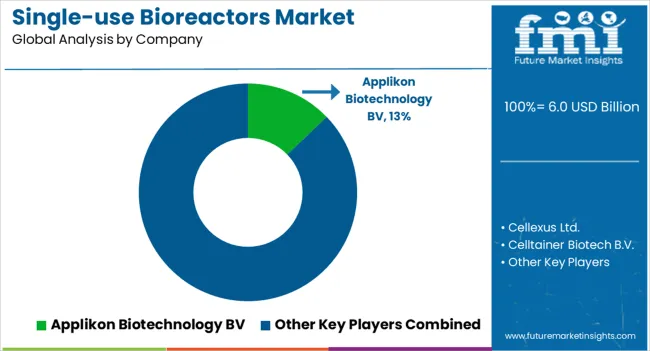
Leading single-use bioreactors manufacturers might invest heavily in research and development to continuously improve their technology. They can focus on enhancing performance, scalability, and compatibility with different cell types, allowing for more efficient and flexible bioprocessing.
Key players would often form partnerships and collaborations with biopharmaceutical companies, contract manufacturing organizations (CMOs), and research institutions. These alliances can facilitate technology sharing, co-development of customized solutions, and expansion of product offerings to address a broader range of applications.
Mergers and acquisitions might play a crucial role in consolidating the market and acquiring complementary technologies or expertise. Key players would strategically acquire smaller companies or start-ups with innovative technologies to strengthen their product portfolios.
Top companies would further invest in customer support and training services to ensure efficient adoption & use of single-use bioreactors. They would provide technical assistance, application support, and training programs to help customers maximize the benefits of their products.
For instance,
| Attribute | Details |
|---|---|
| Estimated Market Size (2025) | USD 6.0 billion |
| Projected Market Valuation (2035) | USD 23.7 billion |
| Value-based CAGR (2025 to 2035) | 14.7% |
| Historical Data | 2020 to 2025 |
| Forecast Period | 2025 to 2035 |
| Quantitative Units | Value (USD billion) |
| Segments Covered | Product, Type, End Use, Region |
| Regions Covered | North America; Latin America; Western Europe; Eastern Europe; South Asia and Pacific; East Asia; Middle East and Africa |
| Key Countries Covered | United States, Canada, Brazil, Mexico, Argentina, Germany, Italy, France, United Kingdom, Spain, BENELUX, Nordics, Czech Republic, Poland, Romania, Hungary, China, Japan, South Korea, India, Association of Southeast Asian Nations, Australia & New Zealand, Kingdom of Saudi Arabia, United Arab Emirates, Türkiye, Saudi Arabia, Algeria, Egypt, Morocco |
| Key Companies Profiled | Applikon Biotechnology BV; Cellexus Ltd.; Celltainer Biotech B.V.; Cesco Bioengineering Co. Ltd.; Danaher Corporation |
| Report Coverage | Revenue Forecast, Volume Forecast, Company Ranking, Competitive Landscape, Growth Factors, Trends and Pricing Analysis |
The global single-use bioreactors market is estimated to be valued at USD 6.0 billion in 2025.
The market size for the single-use bioreactors market is projected to reach USD 23.7 billion by 2035.
The single-use bioreactors market is expected to grow at a 14.7% CAGR between 2025 and 2035.
The key product types in single-use bioreactors market are single-use bioreactor systems, single-use media bags, single-use filtration assemblies and others.
In terms of type, stirred-tank sub segment to command 52.1% share in the single-use bioreactors market in 2025.






Full Research Suite comprises of:
Market outlook & trends analysis
Interviews & case studies
Strategic recommendations
Vendor profiles & capabilities analysis
5-year forecasts
8 regions and 60+ country-level data splits
Market segment data splits
12 months of continuous data updates
DELIVERED AS:
PDF EXCEL ONLINE
Airlift Bioreactors Market - Growth & Forecast 2025 to 2035
Rocking Bioreactors Market
Microbial Bioreactors Market
Small-Scale Bioreactors Market Analysis by Product, Capacity, End-User, and Region through 2035
Continuous Flow Bioreactors Market Analysis - Size, Share, and Forecast Outlook 2025 to 2035
Portable Bioprocessing Bioreactors Market Size and Share Forecast Outlook 2025 to 2035

Thank you!
You will receive an email from our Business Development Manager. Please be sure to check your SPAM/JUNK folder too.
Chat With
MaRIA